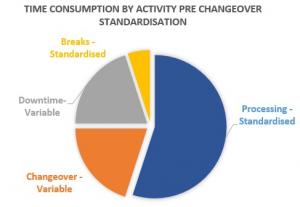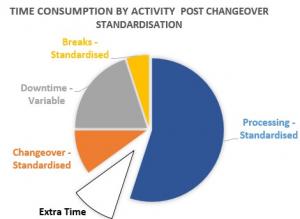Changeover Management in a Controlled Operations Environment
Time in an operational environment can be classified as processing time and non-processing time. Focusing solely on making the processing time efficient is a significant cause of lost improvement opportunities. Standardising variable non-processing time activity (e.g. changeovers) can realise a surprisingly large improvement: a typical changeover standardisation program alone usually achieves 50%+ reduction in changeover times. This increases the time available for processing, but also increases yield and the productivity of resources.
In an Operational environment time can be packaged in 2 categories: (1) Processing time, (2) Non-processing time.
Processing time relates to the “value-adding” work done on materials which leads to the output of a useful product. For this reason processing time tends to get alot of focus. However, focusing on processing time alone can mean that management are losing opportunities for significant improvement.
Non-processing time relates to the other activities that happen in an operation. Identifying and analysing all the activities that consume available time and categorising these activities into (1) processing time and (2) non processing time should be the first step in understanding any operation. Taking this a step further, and categorising “standardised” and “variable” activities is enlighting to understand what ‘really’ happens in an operation.
Then, the primary management focus should be to standardise as much of the “variable” activity as possible (which usually occurs during the non-processing time!)
To understand the activities impacting the time available, position yourself in an operation and record the activities that consume the time available for processing. Figure 1 is a high level representation of what is typically found. (These high level activities form the methodology which is universally recognised as Overall Equipment Effectiveness - OEE).
Figure 1: Operational activities
In controlled environments (like pharmaceutical sites), most operations are automated, validated and recipe-controlled and the only time variation enters the process is when people enter the process. People are required to enter the process to complete certain activities like In Process Testing (IPT), maintenance or changeovers. Different people interacting with a process leads to variation, this variation sub-optimises a process, therefore it makes sense that removing this variation (through standardisation) leads to improvement.
Changeover activity is one of the significant non-processing time activities that consume available time within an operational environment. Changeover activity can be classed as a roadblock or hurdle in the flow of product through the value-stream – it can be defined as “all the activity that is completed in an area or on a piece of equipment between the last “good” product from batch A to the first “good” product of batch B.
Changeover activities are generally hands-on and can include cleaning activities, clearance activities, changing parts, adjustments, calibrations, inspections, etc. These activities are diverse in nature, and in the required skillsets for completion. Also, due to interdependency, the activities need to be completed in a certain sequence. Significant losses occur simply to the variation that can ensue from these diverse, interdependent activities. But if these activities are standardised – sequenced and choreographed in an organised way – significant improvements can be achieved.
A typical changeover standardisation program usually achieves a 50%+ reduction in changeover duration times, which increases the available time for processing, but also increases yield and optimises the use of resources. Reducing changover time increases the time available for value-add processing in an operation.
To achieve the improvements for changeovers there needs to be a management mind-set towards the reduction of process variation then a systematic approach to standardise the changeover process. The key elements for this approach would include a detailed analysis and the deployment of SMED, resource choreography and standard work methodologies resulting in an optimised process which would be managed using visual management.
Figure 2: Pre Standardisation example
Figure 3: Post Standardisation example
In summary, understanding what activities ‘really’ happen within an operation initiates the opportunity to reduce variation and improve OEE. Management focus and a systematic approach to develop a standardised changeover process will realise this opportunity. This article introduces OEE and focuses on changeover management but the principles can also be applied to other downtime activity.
At BSM, as global leaders in implementation of ‘Real Lean’ solutions, we are recognised by our clients as experts in delivering sustainable Lean & Operational excellence programs that meet client requirements.
Our consultants can provide further information on the above and discuss any aspect of Real Lean Transformation, simply set-up a call today.



